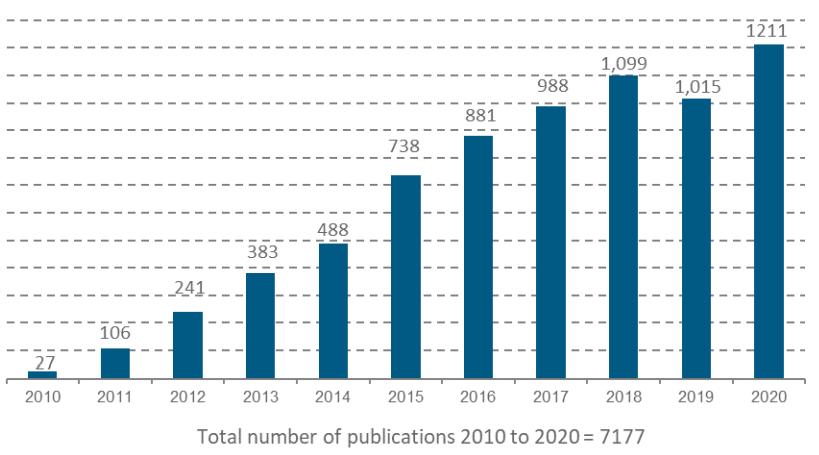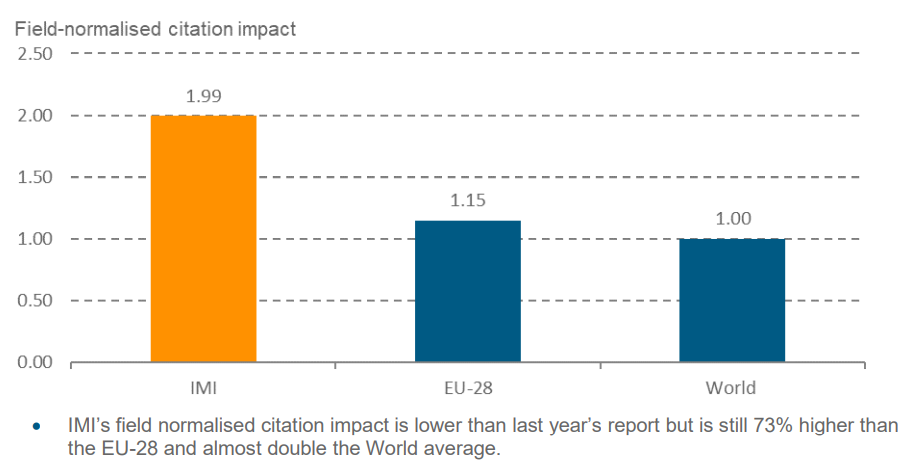Two thirds of IMI project publications appeared in high-impact journals, and more than half were the result of international author collaborations

Every year, IMI analyses the publications produced by IMI projects. The latest report, prepared by Clarivate, presents IMI project publication facts and figures up to the end of 2020. The data show that IMI continues to perform well. Here are some highlights.
Majority published in high-impact journals
IMI projects produced 7,177 publications between 2010 and 2020, with a year-on-year increase. A slight decrease experienced in 2019 was more than compensated for in 2020 thanks to a number of IMI2 projects (such as AIMS-2-Trials, RESCEU, and RHAPSODY), all of which published more than double the number of papers in 2020 than in 2019. The majority of IMI research (67%) continues to be published in high impact journals (ranked according to Clarivate’s Journal Impact Factor).
The topics of research were wide-ranging, from basic biological research to clinical practice, with publications covering pharmacology and pharmacy, neurosciences and biochemistry and molecular biology appearing most frequently.
In the top 10% of papers
The report also looks into the 'field-normalised citation impact' of the papers – an index that is often used as a measure of research quality. The citation impact of IMI project research remains at around twice the world average, which indicates that the research was internationally influential. Between 2010 and 2020, the citation impact of IMI papers was considerably higher (73%) than the European Union’s average citation impact in similar biomedical fields. Around a quarter (25.7%) of IMI project papers were highly cited; that is, the papers were in the world’s top 10% of papers (taking journal category and year of publication into account), when ranked by number of citations.
The below graph shows the average field-normalised citation impact for all IMI papers compared to the average for EU-28 papers in relevant biomedical journal categories and all global papers published between 2010 and 2020.
BTCure has remained the most prolific IMI project, with 703 publications as of this report. INNODIA is new to the list of top 10 most prolific projects, as its publication output grew by 40% since the previous report. The publication output of the AIMS-2-TRIALS project grew by 167%, from 51 publications in 2019 to 136 in 2020.
Highly collaborative
IMI project research is collaborative across sectors, institutions, and countries. This collaborative research shows a higher number of publications compared to non-collaborative research: nearly two-thirds (65.2%) of all IMI project papers were co-authored by researchers working in different sectors, more than three quarters (84.8%) involved collaboration between institutions and more than half (63.3%) were internationally collaborative.
Additionally, IMI’s collaborative research has an average field-normalised citation impact that is almost 50% higher than IMI’s non-collaborative research, and the non-collaborative research field-normalised citation impact was below average for IMI project research.
Key takeaways at a glance
- IMI projects have published a total of 7,177 unique publications
- 25.7% of IMI papers were in the world’s top 10% of most highly cited papers in the relevant field and year of publication, suggesting a very strong performance
- The field-normalised citation impact of IMI project papers was almost twice the world average between 2010 and 2020
- IMI project research had a citation impact well above the European (EU-28) average
- More IMI project publications appeared in Annals of the Rheumatic Diseases and PLOS One than in other journals
- Of the 20 journals in which IMI-funded projects published most frequently, nearly three-quarters (14 journals) rank in the top quartile by Journal Impact Factor
- IMI project research was most frequently published in pharmacology and pharmacy journals
- IMI2 project research was most frequently published in endocrinology and metabolism journals, suggesting that IMI2 projects have had a slightly different focus compared to IMI1 projects
- IMI research in the clinical neurology category has the highest percentage of highly-cited papers
- The largest geographic clusters of research supported by IMI in Europe are London, Amsterdam and Stockholm. The largest clusters in North America are Toronto, Boston and Bethesda
- Nearly two thirds of IMI project papers were co-authored by researchers from different sectors. More than three-quarters involved collaboration between different institutions, and more than half were internationally collaborative
- BTCURE, followed by EU-AIMS, had the highest number of papers with co-authors from more than one country, institution and sector.

